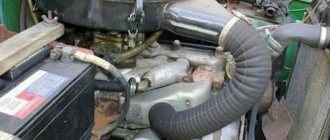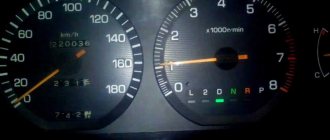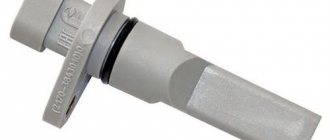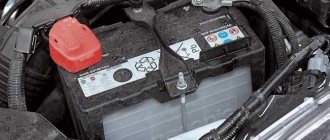An oxygen sensor or lambda probe is a device installed in the exhaust manifold. Its main task is to control the amount of oxygen remaining after combustion of the fuel mixture. According to standards, this mixture is formed in a proportion of 1 to 14.7; if this indicator deviates, the lambda probe transmits a command to the ECU about a violation of the quality of the air-fuel mixture. In some cars, a second probe is installed after the catalyst. If the operation of the oxygen sensor is disrupted or it fails altogether, problems arise in the operation of the engine:
- the car reacts inadequately to pressing the gas pedal;
- there is a smell of fuel in the cabin;
- fuel consumption increases significantly (up to 2 times);
- the exhaust has a pungent odor.
Why do you need an oxygen sensor?
This structural element appeared in 1976, and the first lambda probes were produced by the German concern Bosch. Its appearance was caused by the fact that in the mid-70s of the last century there was a sharp jump in oil prices, so most car owners thought about the efficiency of their cars. Thanks to the sensor, it was possible to achieve noticeable fuel savings without reducing power.
The lambda probe analyzes the amount of unburned oxygen in the exhaust. If there is a lot of it, then the mixture supplied to the cylinders is lean; when there is not enough of it, the air-fuel mixture is too rich. Thanks to this data, the electronic control unit regulates the ratio of air and fuel in the mixture, which allows for maximum operating efficiency, and this leads to fuel savings. The ideal indicator is that 14.7 kg of air should be consumed to burn 1 kg of fuel. The standard oxygen sensor is located in the exhaust manifold.
Since the 90s, two lambda probes began to be installed on cars - an upper oxygen sensor directly at the engine outlet, and a lower sensor after the catalyst. The first probe monitors the quality of the supplied fuel mixture, and the second monitors the condition of the catalyst, which is important for compliance with environmental standards.
Due to poor fuel quality and other problems, the downstream oxygen sensor often fails. They are trying to solve this problem in different ways, one of them is software shutdown, the other is mechanical deception of the lambda probe. This oxygen sensor trick works very simply - an additional hole is made in it or a mesh is installed to allow air to enter from the outside. As a result, the concentration of exhaust and harmful substances in it decreases and the probe believes that everything is fine with the environment. A more reliable option is to flash the ECU.
Oxygen Sensor Identification
The front lambda probe in front of the catalytic converter is usually called the "upstream" sensor or sensor 1.
The rear sensor installed after the catalytic converter is called the downstream sensor or sensor 2.
A typical inline 4-cylinder engine has only one block (bank 1/bank 1). Therefore, in an inline 4-cylinder engine, the term "Bank 1, Sensor 1" simply refers to the front oxygen sensor. "Bank 1, Sensor 2" is the rear oxygen sensor.
Read more: What is Bank 1, Bank 2, Sensor 1, Sensor 2?
A V6 or V8 engine has two blocks (or two parts of that "V"). Typically the cylinder block containing cylinder #1 is called "Bank 1".
Different car manufacturers define Bank 1 and Bank 2 differently. To find out where bank 1 and bank 2 are in your car, you can look in the repair manual or Google, specifying the year, make, model and engine size.
Lambda probe device
To understand the principle of operation of the oxygen sensor, you need to know its structure. The lambda probe has two electrodes. The outer electrode interacts directly with the exhaust, the inner electrode interacts with atmospheric air. Between these electrodes there is a layer of zirconium dioxide. There are titanium probes that do not require contact with the atmosphere, but they are very rare and expensive.
As a result of interaction with different media, different voltages arise on the electrodes, the resulting value of which is transmitted through the wire to the ECU. From these data, a conclusion is drawn about the richness or poverty of the mixture. At values from 0.1 to 0.45 V the mixture is lean, in the range of 0.45-0.9 V the mixture is rich. The ideal air-fuel mixture ratio is achieved at 0.45 V.
The first models of oxygen sensors worked only up to 3000 engine speeds, and after that it switched to average parameters for enriching the mixture. But modern lambda probes operate across the entire rev range, which provides better efficiency and economy.
Varieties
There are several types of sensors. You need to find out what features a particular model has and choose an identical one in the store. But there is a concept of interchangeability, as a result of which a specialist can replace it with another device that has similar, but not equal characteristics.
A popular manufacturing technology is micromechanical. The equipment, which is assembled according to its schemes, is of high quality and provides accurate measurements. Most vehicles use such devices. The principle of operation is that there is a measuring element consisting of tension resistors, a chip and a diaphragm. On the diaphragm side there is a special vacuum chamber. It is into this that the air mixture is injected.
The silicon element is located inside the housing; as a result of changes in the position of the diaphragm due to the incoming air, the voltage of the element increases. The control unit displays information depending on this voltage. A vacuum environment is created when the engine is stopped - there is no pressure, it is equal to atmospheric pressure.
A thick-walled sensor is a slightly different device in its technical characteristics; it shows precise parameters. Consists of four resistors and a thick diaphragm. It is the deformation of the diaphragm that is assessed, which stretches depending on the air supply.
Analog sensors naturally produce an analog signal. But in modern nodes they are practically not used. Due to the fact that digital ones have an additional assembly circuit, are easy to use, and convert the analog signal itself into a digital one, their use seems more reasonable and justified.
Diagnostics
The lambda probe is checked without removing it from the car. To do this, take a special device and attach it to the eclectic system, after which the engine starts. For the sensor to start working, it needs to be heated to 300 degrees, and the titanium probe - to 700.
The voltage values on the device should change in the range from 0.1 to 0.9 V approximately 8 times every 10 seconds. This means that the sensor is working correctly and there are no problems with it. If the frequency of reading changes decreases, the probe is not working properly and will soon fail. In the event of a complete failure, one value is displayed on the screen of the diagnostic device.
Excess air coefficient λ
When analyzing engine performance, the term “stoichiometric ratio” is often used. It means the optimal ratio of oxygen and fuel, at which the prepared mixture burns completely. On the basis of this indicator, internal combustion engine modes and fuel supply features are calculated.
The ideal ratio is 14.7 to 1. It is clear that 14.4 kg of air does not enter the cylinder immediately, but within a certain time period.
The coefficient λ shows the ratio of the actual volume of oxygen entering the cylinder to the ideal parameter (indicated above). In simple words, it shows the deviation of the current amount of air from the optimal parameter.
Taking into account the obtained λ, three options are distinguished:
- 1 - ideal ratio;
- less than 1 - oxygen deficiency and excess gasoline;
- more than 1 - lack of gasoline and excessive amount of air.
Modern internal combustion engines are capable of operating in all cases, but deviations from the norm affect many parameters: acceleration, efficiency, reducing the concentration of harmful components, etc. It is optimal for the coefficient λ to be about 0.9-1.
What happens if the oxygen sensor is faulty?
If the lambda probe malfunctions, when the voltage on it does not change, the ECU begins to enrich the working mixture; it will not lean it, since this leads to more serious consequences.
A specific smell begins to penetrate into the cabin, and fuel consumption doubles. At the same time, the car accelerates much worse, since fuel fills the cylinders, and sometimes characteristic popping sounds are heard from the exhaust pipe.
Interchangeability
You will find out the name of the required device in the vehicle passport. Oxygen variations are replaceable. They install zirconium ones, which have similar designs. Options with heating are always replaced with those without heating, or vice versa. The thread matches. Otherwise, installation of the equipment will not be possible. But if you want to install a single-wire mechanism instead of two, three or wired ones, then you shouldn’t count on luck. The constructive action does not coincide, the unit will work, but will quickly become unusable.
Popular malfunctions include decreased performance and decreased sensitivity. This leads to increased fuel consumption. It is not possible to identify the breakdown yourself in the early stages. You should regularly carry out computer diagnostics and pay attention to the recorded indicators of the on-board system.
What causes lambda probe failure
The design of the oxygen sensor is such that its main enemy is high temperatures. When catalysts are removed without appropriate compensation, the temperature of the exhaust gases increases, which over time leads to probe failure.
The second problem is antifreeze getting into the exhaust gases. But if coolant gets into the combustion chambers, and from them into the exhaust manifold, a breakdown of the oxygen sensor is the least of the problems.
The third common cause of breakdown is oil getting on the electrodes. This happens when the oil thrown out of the engine reaches the turbine, where it burns out, and the vapors enter the lambda probe, which fails. Burning oil spray significantly increases the temperature in the exhaust manifold.
When making tuned exhaust systems, the oxygen sensor is sometimes installed at the bottom. This is a mistake, since the resulting condensation and solid deposits will lead to rapid corrosion of the electrodes, and the device will break. Therefore, the lambda probe is installed on top of the line and at an angle of 45 degrees so that the flow of exhaust gases occurs more correctly.
About the importance of the sensor
The outlet sensor is a device that has a number of functions. The correct injection system ensures universal and uniform fuel consumption and reduces the influence of toxic gases. Since the data is fed into the vehicle's computerized system, it is very important that the dashboard displays accurate data. A motorist will notice a malfunction, and this may happen at the most inopportune moment.
Many characteristics are important while driving. The air temperature is measured, then how cool the liquid is, and the location of the throttle valve is taken into account. The device is necessary to dose fuel. But how it provides information about this is not always clear.
How long does the lambda probe work?
The first versions of oxygen sensors, with two wires, worked in the region of 50 thousand km during normal operation. The new design of probes with three or four wires will work in the region of 80 thousand km. Lambda probes installed in modern cars can last about 150 thousand km before replacement.
A separate subtype of these sensors are broadband lambda probes, which cover at least 150 thousand km, having a number of advantages. They are equipped with a separate output scale, so the driver can see in real time what mixture is being supplied to the engine. This device operates across the entire rev range and processes information at a much higher speed. Such sensors are especially useful for car owners who like to tune their engines.
Video: Lambda! Oxygen sensor and increased fuel consumption
What to do if the mechanism fails
First of all, you need to make sure that the lambda sensor is faulty. In this regard, the easiest and most reliable way is to contact a service station. If you have the desire and opportunity, you can do a visual check yourself. You need to start by inspecting the connectors, checking the reliability of their fixation. Then you should inspect the oxygen sensor:
- Soot on the body is an indicator of combustion of an enriched mixture or excessive overheating of the probe;
- Shiny deposits are created by fuel with excess lead;
- White and gray deposits are caused by the use of oil and fuel additives.
What to do? If lead deposits appear on the lambda sensor, the device must be replaced, since lead damages not only the probe , but also the catalyst . The same applies to deposits from additives. If we talk about soot, you can try to clean it yourself using phosphoric acid.
Wideband lambda probe
There are 2 main types of broadband lambda probes, which differ in the principle of reading information.
- 4-wire. Used on Toyota, Lexus, Subaru, Suzuki cars.
- The 5-wire (possible 6th wire for the calibration resistor) has an additional chamber - an oxygen pump. Usually used on German cars.
These oxygen sensors have a common feature - they do not just show a lean or rich mixture, but are able to measure the composition of the mixture over a wide range. This allows you to more accurately maintain the required mixture composition. It also becomes possible to keep the mixture composition λ not equal to 1. This may be required in transient modes or partial loads, which allows for better efficiency and improves other indicators.
The operating principle of these sensors is described in detail in many sources. Therefore, we will not dwell on it.
Rear lambda probe operation
The catalyst decomposes nitric oxide into nitrogen and oxygen. Free oxygen is also bound to unburnt fuel (from CO we obtain CO2). Many other complex reactions also take place in the catalyst.
As follows from the above, there is noticeably less oxygen behind the catalyst than before the catalyst. The ability of the catalyst to accumulate and release oxygen determines the inertia of changes in oxygen content after the catalyst. Therefore, the main indicator of a serviceable catalyst is the predominance of voltage from the rear lambda probe of more than 0.6 V, even if the voltage of the front lambda probe remains at a low level for a significant time.
READ How to remove the front bumper of a Honda Accord 7
On modern cars with Euro-4 standards and higher, the rear lambda B1S2 also affects fuel corrections in order to ensure the most optimal mixture for the operation of the catalyst. Therefore, the efficiency of the catalyst directly affects fuel consumption. As catalyst efficiency decreases, fuel consumption increases. This occurs because the amount of oxygen that the catalyst decreases, and the system tries to retain it. Adding fuel behind the catalyst.
For example, on modern cars (for example Subaru and some others), aging or lack of a catalyst causes a significant increase in fuel consumption - up to 30% (if no measures are taken to solve the problem with the catalyst). In addition, using lambda, the temperature of the exhaust gases behind the catalyst is measured and the ECU strives to warm up the cold catalyst by controlling the fuel supply and EGR, since the heating time of the catalyst is also regulated by EURO standards (Temperature is determined by measuring the resistance of the lambda heater and the impedance of its sensitive element).
A sign of normal operation of the catalyst with Euro-4 standards and higher is that the voltage at the rear lambda probe is maintained at around 0.6. 0.7 volts at stable operating conditions. At the same time, fuel corrections for the rear B1S2 and front B1S1 lambda probes should be about 0%. If the catalyst is not operating correctly, fuel corrections based on the rear and front sensors may differ greatly from zero.
But not only the voltage from the lambda probe and its dynamic characteristics affect the operation of the control system of a modern engine. Since the lambda depend on the composition of other components in the exhaust gases, the control system can indirectly determine their concentration. The system can also indirectly determine the temperature of the catalyst, which is approximately equal to the temperature of the lambda probe. The internal resistance of its sensitive element and the ceiling of the generated voltage depend on the temperature of the lambda probe. Based on the upper and lower voltage flanges, the ECU can indirectly judge the concentrations of other impurities.
Based on the above, it follows that modern engine control systems are able to not only maintain the oxygen concentration behind the catalyst. Additionally, the temperature of the catalytic converter is kept within the required range, indirectly monitoring and retaining other impurities behind the catalyst.
Diagnostics of the OXYGEN SENSOR (lambda probe) and CATALYST in 5 minutes
Unfortunately, the catalyst has a limited resource. And at the moment when a car owner is faced with a problem with a catalyst, he has a choice - to purchase a new catalyst or solve the problem in another way. Our man, looking at the smoking chimneys of factories and the cost of the catalyst, is of course looking for an alternative option. On modern cars, it is not at all easy to deceive the control unit, since the process involves many parameters with a narrow corridor. Therefore, traditional methods in the form of spacers and resistors with capacitors are no longer suitable. Even if these methods do not work in some cars, fuel consumption inevitably increases. In view of this, manufacturers of catalyst emulators are constantly improving emulation algorithms to most accurately recreate all required parameters. In a modern catalyst emulator, about 10 different parameters are emulated: voltages in various modes, dynamic parameters, the amount of stored oxygen, catalyst efficiency, internal resistance of the sensor, impedance, cut-off time, response to manipulation of the gas pedal, catalyst temperature, warm-up mode, reaction speed of the sensitive element , change in catalyst efficiency with load changes.
READ Hyundai Creta does it need to remove the catalytic converter?
Where is the oxygen sensor located?
The front oxygen sensor DK1 is installed in the exhaust manifold or in the front exhaust pipe in front of the catalytic converter. As you know, the catalytic converter is a major part of the vehicle's emissions control system.
The rear oxygen sensor DK2 is installed in the exhaust after the catalytic converter.
On 4-cylinder engines, at least two lambda probes are installed. V6 and V8 engines have at least four O2 sensors.
The ECU uses the signal from the front oxygen sensor to adjust the air/fuel mixture by adding or decreasing fuel.
The rear oxygen sensor signal is used to monitor the performance of the catalytic converter. Modern cars use an air-fuel ratio sensor instead of a front oxygen sensor. It works similarly, but more accurately.
Method one
Involves cleaning the heating element from carbon deposits (used when a malfunction of the oxygen sensor heater occurs). To implement this method, it is necessary to provide access to the sensitive ceramic part of the device, which is hidden behind a protective cap. You can remove this cap using a thin file, with which you need to make cuts in the area of the base of the sensor. If it is not possible to completely dismantle the cap, then it is possible to make small windows about 5 mm in size. For further work, about 100 ml of orthophosphoric acid or rust converter is needed.
When the protective cap has been completely removed, you will have to use argon welding to restore it to its seat.
The recovery procedure is performed according to the following algorithm:
- Pour 100 ml of phosphoric acid into a glass container.
- Immerse the ceramic sensor element in acid. Do not completely immerse the sensor in acid! After this, wait about 20 minutes for the acid to dissolve the soot.
- Remove the sensor and rinse it with running tap water and then allow it to dry.
Sometimes it takes up to eight hours to clean the sensor using this method, because if you don’t succeed in cleaning the soot the first time, then it makes sense to repeat the procedure two or more times, and you can use a brush to mechanically treat the surface. Instead of a brush, you can use a toothbrush.
Third party sensors
To improve engine performance or simply notice a failed oxygen sensor, car owners turn to options from third-party manufacturers who also produce wideband sensors. To do this, it is better to take products from well-known companies, among which the following are popular:
- AEM performance electronics;
- INNOVATE motorsports;
- Depo Racing.
Each of these brands offers several types and generations of oxygen sensors that offer acceptable levels of accuracy and reliability. There are certain complaints about the broadband probes from Depo Racing, but many experts would argue here too.
INNOVATE motorsports probes require prior calibration. To do this, they need to be connected in air so that they set the desired value, and only then installed in the exhaust system. Sometimes they have problems with controllers and other electronic components. AEM performance electronics have the fewest problems, but they are the most expensive.
When installing a broadband lambda probe, you need to know that it does not tolerate overheating. Therefore, they are installed at a distance of at least 40, and preferably 50 cm from the turbine or the beginning of the exhaust manifold.
Repairing a lambda on a Priora: how to fix it and features of proper cleaning
It makes no sense to repair an oxygen sensor if it has already served more than 100 thousand kilometers. Products rarely last such a period of time, and often problems with them arise already after a mileage of 50 thousand km. If the cause of the product malfunction is a weak response, you can try to repair it. The repair process involves cleaning the surface from carbon deposits. However, removing carbon deposits is not so easy, and such an operation cannot be carried out using a metal brush. The reason for this is the design of the product, since the outer surface contains a layer of platinum coating. Mechanical impact will entail its removal.
To clean the lambda, you can use a simple technique. To do this, you will need phosphoric acid, in which the sensor should be placed. The recommended holding time for the product in acid is 20-30 minutes. For best results, the outer part of the sensor should be removed. This is best done on a lathe. After cleaning in acid, the device should be dried. The cap is returned back by welding it with argon welding. In order not to remove the protective screen, you can make small holes in it and clean through them.
When returning the part back to its place, do not forget to treat the threaded part with graphite lubricant, which will prevent it from sticking to the catalyst body (exhaust manifold).
How to make a mechanical corrector for the exhaust system?
To implement a mechanical blende for the catalyst with your own hands, it is recommended to use blanks made of heat-resistant steel or bronze. This way the parts will not be deformed due to high temperature. There are two designs, but both options require a lathe or the help of an experienced turner.
First option
It is a sleeve 40-100 mm long. On one side, a standard sensor is screwed in, and on the other, the circulation of gases is limited by a small diameter hole. The essence of the “device” is that the composition of the exhaust mixture is averaged, because the lambda probe is removed from the gas stream itself and, accordingly, catches fewer toxic substances. Due to this, it is possible to deceive the ECU.
A typical drawing with spacer dimensions can be changed in terms of dimensions, it depends on the model and brand of the car. The optimal inlet diameter remains unchanged - 1.5-2 mm. In some cases, the length of the bushing may not allow it to be installed in its original place. As a result, you have to weld the mount elsewhere in the exhaust pipe.
Second option
- Exhaust gases enter the bushing body through a small diameter hole.
- In the volume of the spacer, excess CH and CO are subject to oxidation by oxygen, as a result of which the concentration of harmful substances decreases.
- The ongoing processes change the shape of the sinusoid, and the electronic system believes that the catalytic converter is operating normally.
A do-it-yourself catalyst blende made according to the above diagram has advantages similar to the previous option. Here the standard probe will be raised by 32 mm, although this is less than 40-100 mm.
Features of spacer installation
The installation procedure is not difficult, and begins with placing the car on an overpass or lift. Further actions occur according to the following scheme:
- Disconnect the negative terminal of the battery.
- Unscrew the controller.
- Screw the bushing onto the probe.
- Screw the upgraded unit into place.
- Connect the battery.
What does it consist of?
Oxygen sensors for Lada Priora consist of:
- metal case;
- four-pin connector for connecting electrical wiring:
- external electrode (platinum);
- internal electrode (zirconium);
- electrode insulator (ceramics);
- sensor electric heater;
- protective casing of the external electrode.
The lambda probe elements are resistant to high temperatures, as well as to its constant changes. This is due to the fact that its installation location is the engine exhaust system, some areas of which heat up to 900 °C.
Buy a lambda probe decoy
The easiest and most effective way in terms of installation and saving time is to purchase a ready-made oxygen sensor.
In Moscow, a lambda probe blende can be purchased in 2022 for:
- 1500 rubles is for a catalyst emulator (electronic blende). Installation will cost about 500 rubles.
- Up to 1400 rubles - this is for the corner version of the blende.
- Up to 1200 rubles - this is for the second lambda sensor with a metal minicatalyst. Suitable for vehicles with Euro 4 engines.
- 500 rubles is for the most common option, a mechanical blende manufactured by Fort Luft. It does not contain a microcatalyst. Installed on cars up to 2001.
Varieties of hand-made trompe l'oeil
A decoy, also known as an emulator, is a device that does not determine the oxygen content in gases. It only serves to fool the car's electronic control unit.
Changed controller firmware
You can reflash it yourself by downloading the software and instructions on how to do it. It's better to give it to a specialist. In electronic mode, the oxygen sensor is turned off through a certain program. In fact, it should turn out that the ECU will receive only the most correct value from the catalyst and there will be no errors on the instrument panel.
Repair
The types of work performed depend on what signs of malfunction were identified during the diagnosis.
Wiring repair
If visible or internal violations are detected, the wiring must be repaired or replaced.
Connector repair
In case of mechanical failure of the connector, it must be replaced, since it will not provide insulation of the connected contacts.
If the connector becomes oxidized, it must be reconnected and the contacts cleaned.
Cleaning (temporary measure)
During the operation of the vehicle, a significant layer of carbon deposits accumulates on the surface of the sensor.
Cleaning is carried out using phosphoric acid and a brush made of soft material. The outer electrode and protective casing must be soaked for about 20 minutes until the accumulated carbon deposits are removed, or cleaned with a brush.
It is not recommended to use products made from hard materials, for example: metal brushes, screwdrivers, sandpaper.
After cleaning, the lambda probe must be completely dried.
Replacement
Replacing the first or second sensor consists of the following steps:
- disconnecting the connector;
- removing the lambda probe from the exhaust system;
- installing a known-good sensor;
- connector connection.
After repairing, cleaning or replacing the elements of the lambda probe, it is necessary to recheck its operation by starting the engine and warming it up to operating temperature.
Do-it-yourself electronic catalyst blende and emulator circuit
A real electronic emulator is a microprocessor device consisting of a single-chip microcircuit. The principle of its operation is based on the formation of an output signal, which in shape corresponds to the information in the working neutralizer. This option is difficult to do on your own, so you should immediately consider a simpler method. To implement it you need to prepare:
- Electric soldering iron.
- Solder and rosin.
- Knife and side cutters.
- Resistance 200 Kom, power 0.25 W.
- The capacitor is non-polar with a capacity of 4.7 microfarads.
The principle of operation of the system is to average the readings of the oxygen sensor, which is installed after the converter. The method of connecting emulator components is simple and universal. All elements are connected directly to the vehicle’s on-board network conductors. Before connecting the electronic decoy to the catalyst with your own hands, you should disconnect the battery to eliminate the possibility of a short circuit. After the implementation of the project, the car demonstrates good dynamics. However, the effect of over-enrichment of the combustible mixture may occur, which causes the deposition of a layer of soot in the exhaust manifold. In addition, on some models error P0133 appears, indicating a low response rate of the lambda probe.
Where to buy car accessories
Spare parts and other products for the car are easily available for purchase at auto stores in your city. But there is another option that has recently received significant improvements. You no longer need to wait a long time for a parcel from China: the AliExpress online store now offers the opportunity to ship from transshipment warehouses located in various countries. For example, when ordering, you can specify the “Delivery from the Russian Federation” option.
Follow the links and choose:
| Lambda probe, oxygen sensor for Lada Samara, Kalina, Priora | Eunavi s car alarm system, central kit with remote control | Car radar detector YASOKRO V7, 360 degrees |
| Radar detector Karadar STR G820 Led 2 in 1, radar detector with GPS | Auto radar detector 12V | Digital air/fuel ratio sensor Dynoracing for Lada Priora |











